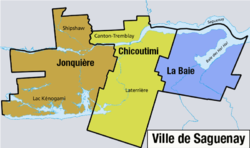Jonquière
| Jonquière | |
|---|---|
| Borough | |

Arvida Bridge in Jonquière.
|
|
 |
|
| Country | Canada |
| Province | Quebec |
| Region | Saguenay–Lac-Saint-Jean |
| City | Saguenay |
| Government | |
| • Borough president | Réjean Laforest |
| Website | Borough Council of Jonquière |
Jonquière (/ʒɒŋˈkjɛər/; French pronunciation: [ʒɔ̃kjɛʁ]; 2011 population: 54,072) is a borough (arrondissement) of the city of Saguenay in the Saguenay–Lac-Saint-Jean region of Quebec, Canada. It is located on the Saguenay River, near the borough of Chicoutimi.
Jonquière was founded in 1847 by Marguerite Belley, who came from La Malbaie to settle on the Rivière aux Sables. It was named after the Marquis de La Jonquière, governor of New France from 1749 to 1752.
Growth came from the construction of pulp and paper mills at the beginning of the 20th century. Between 1925 and 1928, the world's largest aluminum plant was built along with the city Arvida (then a separate town). In 1942, to supply power to the plant, Alcan built a hydroelectric station at Shipshaw that was the largest in the world at that time. Jonquière, Arvida, and Kénogami were amalgamated into a single city, Jonquière, in 1975. Jonquière was the host city for the Quebec Games in the winter of 1976, and for the Canoe/Kayak World Championships in slalom and whitewater racing, in 1979.
Much of Jonquière's development owed its strength to the Price family, who ran a pulp and paper factory in Kénogami. Today that factory is owned by Abitibi-Consolidated. Arvida is the home of an aluminium plant owned by Rio Tinto Alcan.
When the city of Saguenay was constituted on February 18, 2002 by municipal amalgamation, the borough of Jonquière was created from the former city of Jonquière, the former municipality of Shipshaw, and the former municipality of Lac-Kénogami. The former city of Jonquière had a population of 54,842 in the Canada 2001 Census, the last census in which Jonquière was counted as a separate city.
...
Wikipedia
